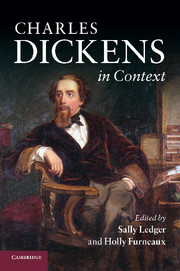Book contents
- Frontmatter
- Contents
- List of illustrations
- Notes on contributors
- Preface
- Notes on references
- PART I LIFE AND AFTERLIFE
- 1 The life of Dickens 1: before Ellen Ternan
- 2 The life of Dickens 2: after Ellen Ternan
- 3 Dickens's lives
- 4 Victorian stage adaptations and novel appropriations
- 5 Reviewing Dickens in the Victorian periodical press
- 6 The European context
- 7 Major twentieth-century critical responses
- 8 Modern stage adaptations
- 9 Modern screen adaptations
- 10 The heritage industry
- 11 Neo-Victorian Dickens
- PART II SOCIAL AND CULTURAL CONTEXTS
- Further reading
- Index
4 - Victorian stage adaptations and novel appropriations
Published online by Cambridge University Press: 05 August 2012
- Frontmatter
- Contents
- List of illustrations
- Notes on contributors
- Preface
- Notes on references
- PART I LIFE AND AFTERLIFE
- 1 The life of Dickens 1: before Ellen Ternan
- 2 The life of Dickens 2: after Ellen Ternan
- 3 Dickens's lives
- 4 Victorian stage adaptations and novel appropriations
- 5 Reviewing Dickens in the Victorian periodical press
- 6 The European context
- 7 Major twentieth-century critical responses
- 8 Modern stage adaptations
- 9 Modern screen adaptations
- 10 The heritage industry
- 11 Neo-Victorian Dickens
- PART II SOCIAL AND CULTURAL CONTEXTS
- Further reading
- Index
Summary
Though the 1737 Theatre Regulation Act granted only two theatres – Covent Garden and Drury Lane – the right to perform ‘legitimate’ drama that relied on spoken dialogue, the theatre was an increasingly popular entertainment throughout the nineteenth century. Audiences of all classes were drawn by the great actors (the nineteenth-century theatre was until quite late in the century a theatre of performance rather than text), the new stage effects and talented stage painters. Many other theatres got around the 1737 law by staging plays, including adaptations of Dickens's novels that included mime, music, dance, spectacle, song.
The introduction of music and song into the performances was made somewhat easier by the dominance of melodrama as a major dramatic form (even Covent Garden and Drury Lane staged melodramas) during the period, since ‘melodrama’, meaning ‘mixed drama’, was already a combination of music and action. In terms of comedy, farce and parody were easily linked with the form of burletta, a popular genre of comic opera. Moreover, there was throughout the first half of the century a burst of theatre building; by 1807 at least seven important new ‘minor’ theatres had been licensed in London, including the Adelphi and the Olympic, both of which were to stage Dickens adaptations, and in 1850 Charles Kean opened the plush Princess Theatre designed to attract a middle-class audience.
- Type
- Chapter
- Information
- Charles Dickens in Context , pp. 27 - 34Publisher: Cambridge University PressPrint publication year: 2011
- 2
- Cited by



